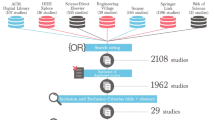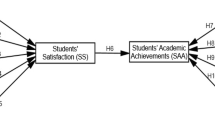Abstract
The appearance of massive open online courses has caused an increase in the volume of open online educational videos on the web. Therefore, there is a vast amount of information to be managed by the Internet users. The present work aims to optimize the educational video lecture searching in social networks. The research presents a novel ranking procedure for the educational video lectures that takes into account their popularity with content-based social media communities. The popularity formula combines quantitative and qualitative characteristics, taking into account not only the positive and the negative elements of the web page containing the video, but also the opinion of the users based on their comments. Thus, a novel social parameter is proposed which is embedded in the content-based ranking process. Furthermore, a user evaluation procedure is carried out, and initial results indicate that this integration produces a ranking output that better matches the user’s preferences.





Similar content being viewed by others
References
Ali NH, Ibrahim NS (2012) Porter stemming algorithm for semantic checking. In: Proceedings of 16th international conference on computer and information technology, pp 253–258
Balakrishnan V, Gan CL (2016) Students’ learning styles and their effects on the use of social media technology for learning. Telemat Inf 33(3):808–821
Blankenship M (2011) How social media can and should impact higher education. Educ Dig 76(7):39–42
Chatzopoulou G, Sheng C, Faloutsos M (2010) A first step towards understanding popularity in youtube. In: INFOCOM IEEE conference on computer communications workshops, 2010. IEEE, pp 1–6
Chelaru SV, Orellana-Rodriguez C, Altingovde IS (2012) Can social features help learning to rank youtube videos? In: International conference on web information systems engineering. Springer, pp 552–566
Chen H, Zimbra D (2010) Ai and opinion mining. IEEE Intell Syst 25(3):74–80
Deldjoo Y, Elahi M, Cremonesi P, Garzotto F, Piazzolla P, Quadrana M (2016) Content-based video recommendation system based on stylistic visual features. J Data Semant 5:1–15
Fernandez M, d’Aquin M, Motta E (2011) Linking data across universities: an integrated video lectures dataset. In: International semantic web conference. Springer, pp 49–64
Figueiredo F, Almeida JM, Gonçalves MA, Benevenuto F (2014) On the dynamics of social media popularity: a youtube case study. ACM Trans Internet Technol 14(4):24
Gou L, Zhang XL, Chen HH, Kim JH, Giles CL (2010) Social network document ranking. In: Proceedings of the 10th annual joint conference on digital libraries. ACM, pp 313–322
Hofmann M, Klinkenberg R (2013) RapidMiner: data mining use cases and business analytics applications. CRC Press, Boca Raton
Hu M, Liu B (2004) Mining and summarizing customer reviews. In: Proceedings of the tenth ACM SIGKDD international conference on Knowledge discovery and data mining. ACM, pp 168–177
Jungermann F (2009) Information extraction with rapidminer. In: Proceedings of the GSCL symposium sprach technologie und eHumanities. Citeseer, pp 50–61
Khodaei A, Shahabi C (2012) Social-textual search and ranking. CrowdSearch 37(5):3–8
Klobas JE, Mackintosh B, Murphy J (2014) The anatomy of moocs. Massive open online courses: The MOOC Revolution, pp 1–22
Kravvaris D, Kermanindis KL (2015) An analysis of online educational videos in social media based on verbal content. In: 2015 6th international conference on information, intelligence, systems and applications (IISA). IEEE, pp 1–6
Kravvaris D, Kermanindis KL, Chorianopoulos K (2015) Ranking educational videos: the impact of social presence. In: 2015 IEEE 9th international conference on research challenges in information science (RCIS). IEEE, pp 342–350
Krutka DG, Carpenter JP (2016) Why social media must have a place in schools. Kappa Delta Pi Record 52(1):6–10
Liu B (2012) Sentiment analysis and opinion mining. Synth Lect Hum Lang Technol 5(1):1–167
Manca S, Ranieri M (2016) Facebook and the others. potentials and obstacles of social media for teaching in higher education. Comput Educ 95:216–230
Manning CD, Raghavan P, Sch\(\ddot{u}\)tze H (2008) Introduction to information retrieval, vol 1. Cambridge university press, Cambridge, p 496.
Nie B, Zhang H, Liu Y (2014) Social interaction based video recommendation: recommending youtube videos to facebook users. In: 2014 IEEE conference on computer communications workshops (INFOCOM WKSHPS). IEEE, pp 97–102
Park J, Cardie C (2014) Identifying appropriate support for propositions in online user comments. In: Proceedings of the first workshop on argumentation mining, pp 29–38
Shortell T (2001) An introduction to data analysis & presentation. World Wide Web: http://academic.brooklyn.cuny.edu/soc/courses/712/chap18.html
Siemens G (2013) Massive open online courses: innovation in education. Open educational resources: innovation, research and practice 5
Szabo G, Huberman BA (2010) Predicting the popularity of online content. Commun ACM 53(8):80–88
Telang A, Li C, Chakravarthy S (2012) One size does not fit all: toward user-and query-dependent ranking for web databases. IEEE Trans Knowl Data Eng 24(9):1671–1685
Wang Y, Luo Z, Yu Y (2016) Learning for search results diversification in twitter. In: International conference on web-age information management. Springer, pp 251–264
Willett P (2006) The porter stemming algorithm: then and now. Program 40(3):219–223
Yew J, Shamma DA, Churchill EF (2011) Knowing funny: genre perception and categorization in social video sharing. In: Proceedings of the SIGCHI conference on human factors in computing systems. ACM, pp 297–306
Yu H, Kim S (2012) Svm tutorial—classification, regression and ranking. In: Handbook of Natural computing. Springer Berlin Heidelberg, pp 479–506
Zachara M, Pałka D (2016) Comparison of text-similarity metrics for the purpose of identifying identical web pages during automated web application testing. In: Information systems architecture and technology: proceedings of 36th international conference on information systems architecture and technology–ISAT 2015–Part II. Springer, pp 25–35
Zhou R, Khemmarat S, Gao L, Wan J, Zhang J (2016) How youtube videos are discovered and its impact on video views. Multimed Tools Appl 75:1–24
Author information
Authors and Affiliations
Corresponding author
Rights and permissions
About this article
Cite this article
Kravvaris, D., Kermanidis, K.L. Advanced searching framework for open online educational video lectures. Soc. Netw. Anal. Min. 7, 31 (2017). https://doi.org/10.1007/s13278-017-0452-3
Received:
Revised:
Accepted:
Published:
DOI: https://doi.org/10.1007/s13278-017-0452-3




